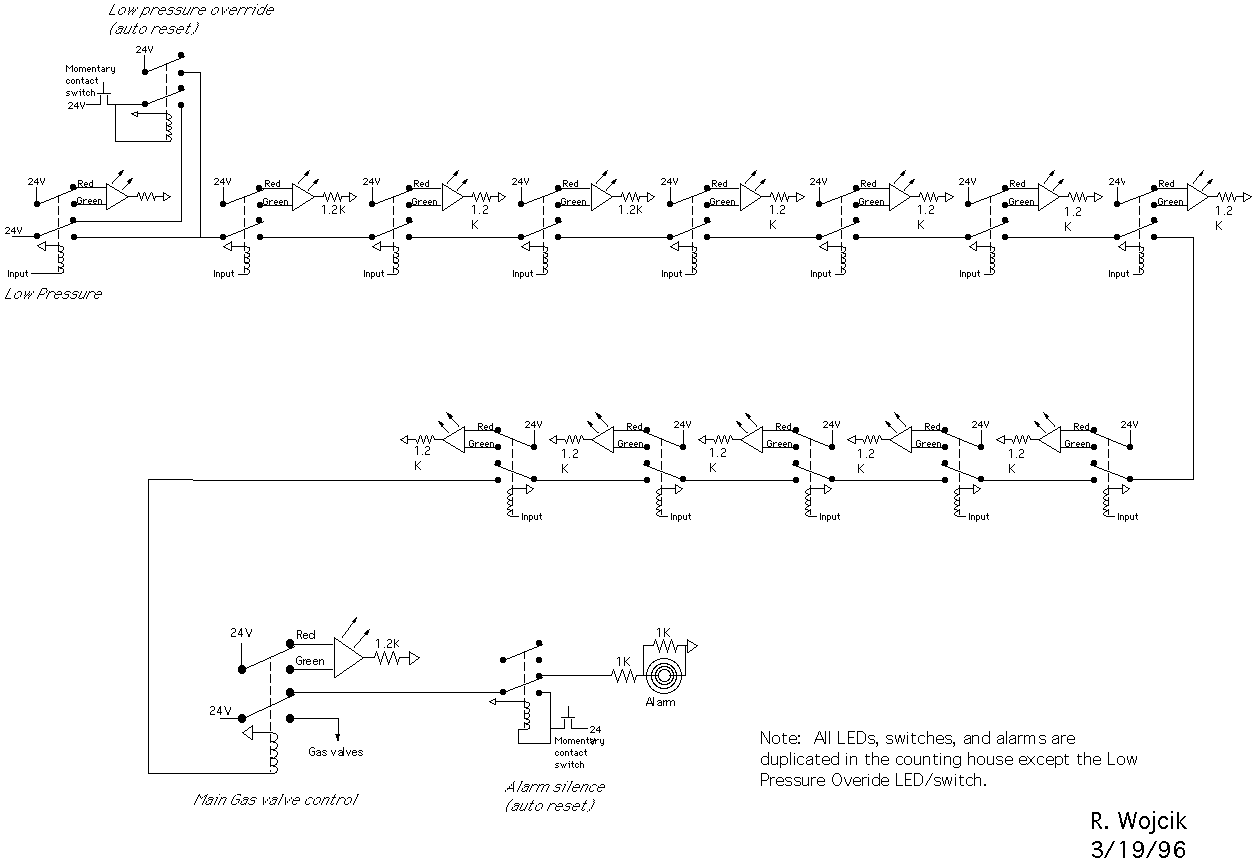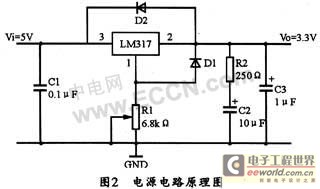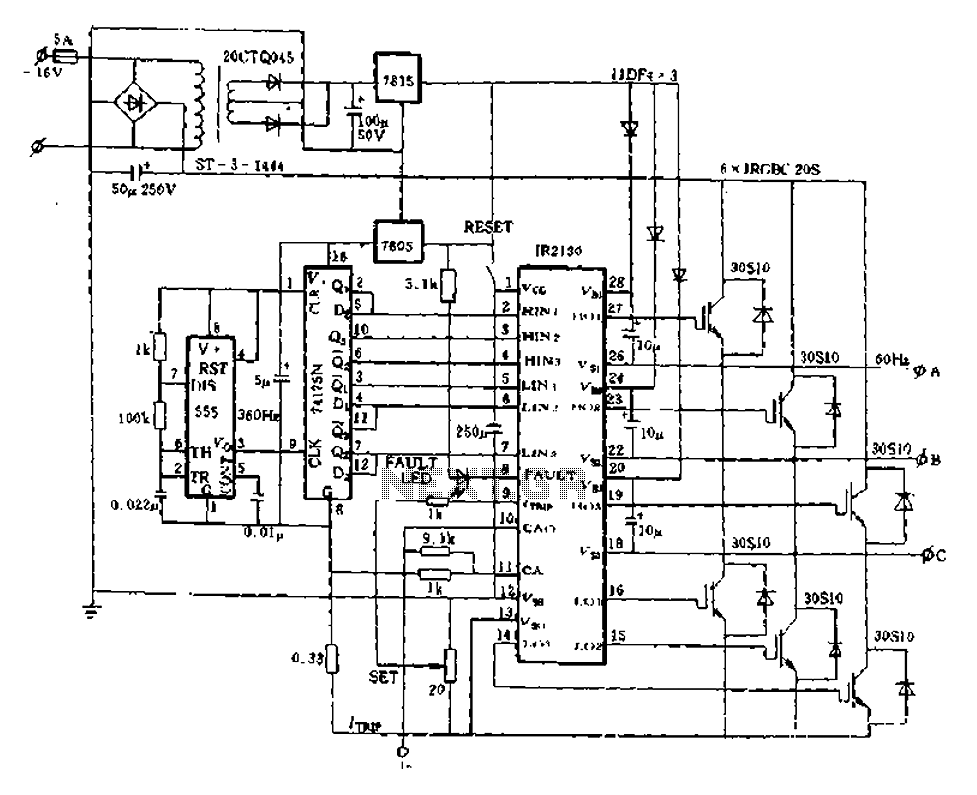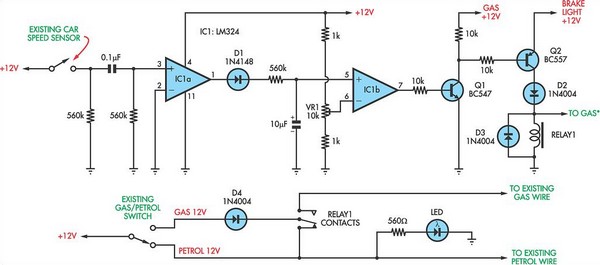
The Hall A Wire-chamber Gas System Ops Manual

Two detector systems in the Hall-A spectrometers utilize potentially flammable gases: the Vertical Drift Chambers (VDC) and the Focal Plane Polarimeter (FPP) straw tubes. This document aims to provide a user manual for the gas supply system and fulfill the formal requirement for a written operating procedure. Readers interested in safety systems and compliance with safety regulations are directed to sections including Overview, Interlocks, Checklist, Interlock System, Calculation of Hazard Class, Refrigerator Safety, and Call List. Currently, both detector systems (FPP and VDC) use a mixture of Argon and Ethane in approximately equal proportions, along with about 1% ethanol. The Argon and Ethane are sourced from high-pressure gas bottles and mixed in the desired ratio through a mixing system, which then passes the mixture through a bath of ethyl alcohol maintained at a constant temperature. The gas mixture is distributed to gas racks in the Hadron Spectrometer and the Electron Spectrometer. The transmission lines and distribution plumbing have been designed as if the FPPs and VDCs were independent systems using different gas mixtures, facilitating a future transition to such systems. Additionally, a source of purge gas, currently pure Argon, is provided. The distribution racks allow for the selection of either operating gas or purge gas, flow control and metering, overpressure relief to protect the detector components, exhaust flow measurement, and backflow prevention. The bulk gas supply consists of two bottles each of Argon and Ethane. With the exception of fittings that vary by gas type, the plumbing for both supplies is identical. One bottle of each gas is continuously connected to the gas shed supply via Matheson model 8590 controllers located inside the Hall A Gas Shed. The pressure in each bottle is monitored by a pressure switch that signals the Matheson model 8590 controller to switch from an empty to a full cylinder. Local pressure readings are available through mechanical pressure gauges on each flex hose. A pressure regulator for each gas type reduces the pressure to approximately 45 psig, which is the pressure at which gas is supplied to the gas shed. This pressure can be monitored by outlet pressure gauges (PG-022, -023) on the regulators and inside the gas shed on gauges PG-132, -133. Before entering the shed, the gas passes through manual valves (MV-032, -033), Excess Flow Valves (XF-042, -043), and Solenoid Valves (AV-052, -053). The Excess Flow Valves automatically close if the flow rate exceeds approximately 4 slpm at 45 psig and must be manually reset after tripping. The solenoid valves are electrically operated (24 VDC) normally-closed valves, requiring power to be supplied for gas flow. Valve power is provided by the Gas Interlock System when interlock conditions are met, including adequate gas pressure downstream of the solenoid valves. Operators must utilize the manual "Low Pressure Override" pushbutton on the interlock panel in the mixing room to initially establish the 45 psig supply pressure. The pushbutton circuit automatically re-arms once sufficient pressure is detected by pressure switches (PS-112, -113), located just above gauges PG-132 and -133. Below these gauges are overpressure relief valves (RV-122, -123), which activate if supply pressure exceeds about 60 psig. After passing through check valves that prevent backstreaming, the three gas supplies enter the mixing system.
The gas supply system for the Hall-A spectrometers is designed with safety and efficiency in mind, ensuring that potentially flammable gases are handled properly. The mixing system plays a crucial role in maintaining the correct gas ratios essential for the operation of the VDC and FPP systems. The integration of safety features such as Excess Flow Valves and overpressure relief valves is paramount, as they provide critical protection against hazardous conditions that could arise due to gas leaks or pressure fluctuations.
The use of high-pressure gas bottles necessitates robust monitoring and control systems. The Matheson model 8590 controllers ensure that the gas supply is managed seamlessly, with real-time pressure monitoring allowing for immediate response to any changes in gas bottle status. The inclusion of mechanical pressure gauges provides an additional layer of safety, allowing operators to visually verify the pressure levels before proceeding with operations.
The solenoid valves, being normally closed, enhance safety by ensuring that gas flow is only permitted when all interlock conditions are satisfied. This design minimizes the risk of accidental gas release, which is particularly important in environments where flammable gases are utilized. The manual "Low Pressure Override" feature allows for controlled initial gas flow, while the automatic re-arming of the system ensures that operators are alerted to any potential issues with gas pressure.
Overall, the gas supply and mixing system for the Hall-A spectrometers is a sophisticated assembly that prioritizes safety, reliability, and operational efficiency. The detailed design and implementation of each component reflect the critical nature of the applications involved and the need for stringent adherence to safety regulations.Two detector systems in the Hall-A spectrometers make use of potentially flammable gasses: the Vertical Drift Chambers (VDC) and the Focal Plane Polarimeter (FPP) straw tubes. This document is intended to address the practical need for a users manual for this gas supply system as well as the formal requirement for a written operating procedure.
Th e reader specifically interested in safety systems and compliance with safety regulations is referred to the sections Overview, Interlocks, Checklist, Interlock System, Calculation of Hazard Class, Refrigerator Safety, and Call List. As of this writing both detector systems (FPP and VDC) are using a mixture of Argon and Ethane in roughly equal proportions, plus about 1% ethanol.
The Argon and Ethane are supplied from high-pressure gas bottles. They are combined in the desired proportion by a mixing system and this mixture is passed through a bath of ethyl alcohol which is maintained at a fixed temperature. See Figure 2. 3-1 for a schematic diagram of the gas supply / mixing system. The gas mixture is delivered to gas distribution racks in the Hadron Spectrometer and the Electron Spectrometer.
The transmission lines and the distribution plumbing have been designed as if the FPPs and VDCs were actually independent systems using different gas mixtures. This design was chosen in order to ease the expected transition to such a system in the future. Also supplied is a source of purge gas, currently pure argon. The distribution racks provide, for each detector, selection of either operating gas or purge gas, flow control and metering, overpressure relief to protect the detector components, exhaust flow measurement, and backflow prevention.
The bulk gas supply consists of two bottles each of Argon and Ethane. Except for fittings which vary by type of gas the two supplies have identical plumbing. One of the bottles for each gas is connected to the gas shed supply at all times by the Matheson model 8590 controllers inside the Hall A Gas Shed. The pressure in each bottle is sensed by a pressure switch whose signal is used by the Matheson model 8590 controller to change from an empty cylinder to a full cylinder.
The pressure of each bottle is also indicated locally by a mechanical pressure gauge on each flex hose. A pressure regulator for each type of gas reduces the pressure to approximately 45 psig. This is the pressure at which gas is supplied to the gas shed. It may be monitored by the outlet pressure gauges (PG-022, -023) on the pressure regulators and, inside the gas shed, on gauges PG-132, -133.
Prior to entering the shed the gas passes through manual valves (MV-032, -033), Excess Flow Valves (XF-042, -043), and Solenoid Valves (AV-052, -053). The Excess Flow Valves automatically close if the flow rate exceeds about 4 slpm at 45 psig. These valves must be manually reset after they trip. Refer to the section. Resetting a closed Excess Flow Valve for this procedure. The solenoid valves are electrically operated (24 VDC) normally-closed valves. Power must be supplied to the solenoids in order for gas to flow. Valve power is supplied, when interlock conditions are satisfied, by the Gas Interlock System. Note that one of the required interlock conditions is that there be ample gas pressure downstream of the solenoid valves.
System operators must use the manual "Low Pressure Override" pushbutton on the interlock panel (in the mixing room) in order to initially bring up the 45 psig supply pressure. The pushbutton circuit automatically re-arms after ample pressure is detected by the pressure switches (PS-112, -113).
These switches are located immediately above gauges PG-132 and -133. Just below these gauges are overpressure relief valves (RV -122, -123) which have been set to release if the supply pressure exceeds about 60 psig. After passing through check valves which prevent backstreaming the three gas supplies enter the mixing syst
🔗 External reference
The gas supply system for the Hall-A spectrometers is designed with safety and efficiency in mind, ensuring that potentially flammable gases are handled properly. The mixing system plays a crucial role in maintaining the correct gas ratios essential for the operation of the VDC and FPP systems. The integration of safety features such as Excess Flow Valves and overpressure relief valves is paramount, as they provide critical protection against hazardous conditions that could arise due to gas leaks or pressure fluctuations.
The use of high-pressure gas bottles necessitates robust monitoring and control systems. The Matheson model 8590 controllers ensure that the gas supply is managed seamlessly, with real-time pressure monitoring allowing for immediate response to any changes in gas bottle status. The inclusion of mechanical pressure gauges provides an additional layer of safety, allowing operators to visually verify the pressure levels before proceeding with operations.
The solenoid valves, being normally closed, enhance safety by ensuring that gas flow is only permitted when all interlock conditions are satisfied. This design minimizes the risk of accidental gas release, which is particularly important in environments where flammable gases are utilized. The manual "Low Pressure Override" feature allows for controlled initial gas flow, while the automatic re-arming of the system ensures that operators are alerted to any potential issues with gas pressure.
Overall, the gas supply and mixing system for the Hall-A spectrometers is a sophisticated assembly that prioritizes safety, reliability, and operational efficiency. The detailed design and implementation of each component reflect the critical nature of the applications involved and the need for stringent adherence to safety regulations.Two detector systems in the Hall-A spectrometers make use of potentially flammable gasses: the Vertical Drift Chambers (VDC) and the Focal Plane Polarimeter (FPP) straw tubes. This document is intended to address the practical need for a users manual for this gas supply system as well as the formal requirement for a written operating procedure.
Th e reader specifically interested in safety systems and compliance with safety regulations is referred to the sections Overview, Interlocks, Checklist, Interlock System, Calculation of Hazard Class, Refrigerator Safety, and Call List. As of this writing both detector systems (FPP and VDC) are using a mixture of Argon and Ethane in roughly equal proportions, plus about 1% ethanol.
The Argon and Ethane are supplied from high-pressure gas bottles. They are combined in the desired proportion by a mixing system and this mixture is passed through a bath of ethyl alcohol which is maintained at a fixed temperature. See Figure 2. 3-1 for a schematic diagram of the gas supply / mixing system. The gas mixture is delivered to gas distribution racks in the Hadron Spectrometer and the Electron Spectrometer.
The transmission lines and the distribution plumbing have been designed as if the FPPs and VDCs were actually independent systems using different gas mixtures. This design was chosen in order to ease the expected transition to such a system in the future. Also supplied is a source of purge gas, currently pure argon. The distribution racks provide, for each detector, selection of either operating gas or purge gas, flow control and metering, overpressure relief to protect the detector components, exhaust flow measurement, and backflow prevention.
The bulk gas supply consists of two bottles each of Argon and Ethane. Except for fittings which vary by type of gas the two supplies have identical plumbing. One of the bottles for each gas is connected to the gas shed supply at all times by the Matheson model 8590 controllers inside the Hall A Gas Shed. The pressure in each bottle is sensed by a pressure switch whose signal is used by the Matheson model 8590 controller to change from an empty cylinder to a full cylinder.
The pressure of each bottle is also indicated locally by a mechanical pressure gauge on each flex hose. A pressure regulator for each type of gas reduces the pressure to approximately 45 psig. This is the pressure at which gas is supplied to the gas shed. It may be monitored by the outlet pressure gauges (PG-022, -023) on the pressure regulators and, inside the gas shed, on gauges PG-132, -133.
Prior to entering the shed the gas passes through manual valves (MV-032, -033), Excess Flow Valves (XF-042, -043), and Solenoid Valves (AV-052, -053). The Excess Flow Valves automatically close if the flow rate exceeds about 4 slpm at 45 psig. These valves must be manually reset after they trip. Refer to the section. Resetting a closed Excess Flow Valve for this procedure. The solenoid valves are electrically operated (24 VDC) normally-closed valves. Power must be supplied to the solenoids in order for gas to flow. Valve power is supplied, when interlock conditions are satisfied, by the Gas Interlock System. Note that one of the required interlock conditions is that there be ample gas pressure downstream of the solenoid valves.
System operators must use the manual "Low Pressure Override" pushbutton on the interlock panel (in the mixing room) in order to initially bring up the 45 psig supply pressure. The pushbutton circuit automatically re-arms after ample pressure is detected by the pressure switches (PS-112, -113).
These switches are located immediately above gauges PG-132 and -133. Just below these gauges are overpressure relief valves (RV -122, -123) which have been set to release if the supply pressure exceeds about 60 psig. After passing through check valves which prevent backstreaming the three gas supplies enter the mixing syst
🔗 External reference





